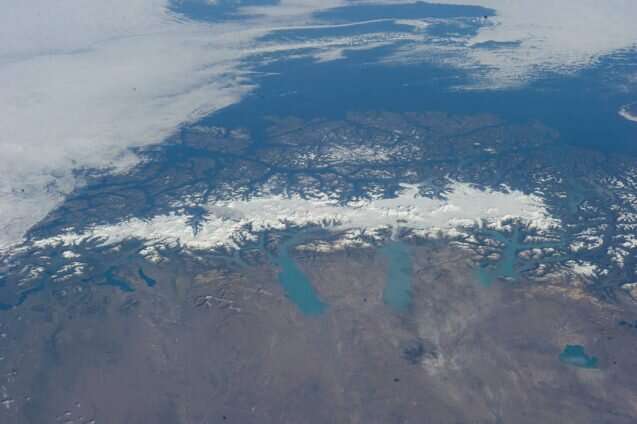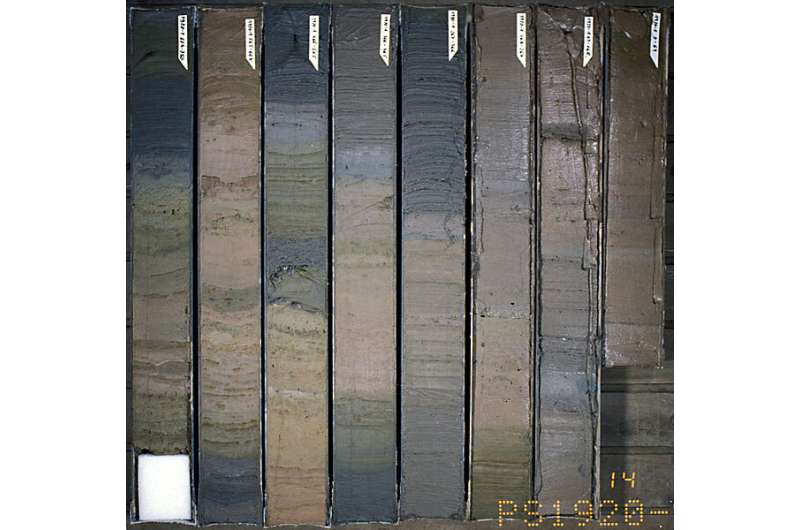
A team of researchers began their journey around frigid Patagonia, moving through water channels to reach the fjords, surrounded by ice and snow. They withstood freezing temperatures throughout their journey, all in the hope of extracting the perfect sediment core: the key to glacial history in the Southern Patagonian Ice Field.
Over the course of their research, which led to a study recently published in Quaternary Science Reviews, lead author Matthias Troch of Ghent University and his colleagues geochemically analyzed a 12.2 meter-long sediment core from an area in Patagonia called the Wide Channel to determine when glaciers retreated and stabilized in the geological past. Their findings on glacial waxing and waning patterns may offer insights as to how the area's glaciers may respond in the future as global temperatures increase.
Located in the southernmost part of South America, the Southern Patagonian Ice Field, where the team did its research, is one of two major ice fields in the Patagonian Andes. Ice fields are a series of interconnected ice caps and glaciers. Patagonia's Northern and Southern Ice Fields are the largest in the Southern Hemisphere, apart from those in Antarctica. They are home to some of the world's fastest-flowing glaciers, and ice flow speeds vary between glaciers across the ice fields.
The Southern Patagonia Ice Field stretches north to south for 220 miles, and it's drained by 53 main outlet glaciers. The remote landscape is characterized by a chilly, snowy climate with high mountain peaks and clouds that block most incoming sunlight. Westerly winds take up large amounts of moisture as they cross the Pacific, releasing up to 160 inches of precipitation onto the peaks each year. The elements pose many challenges for researchers seeking to understand the shrinking glaciers in the area; many are forced to spend weeks waiting for weather conducive to traveling, and researchers are often stuck in tents for long periods while waiting for unfavorable weather to clear.
As ice flows through glaciers, it grinds up rock into fine particles as it passes over the bedrock. These fine particles are carried by streams that flow out of the glaciers, and the sediments are eventually deposited in oceans and glacier-fed lakes. As these sediments are deposited, they create distinct layers, each from a different period of time. Researchers then approach these sites with cylindrical tools, extracting long, cylindrical samples of sediment: these samples are sediment cores. Sediment cores, though fascinating in and of themselves, contain a record of past glacial activity.
The research team traveled through the Wide Channel alongside the ice fields, collecting samples from the fjord by boat. Sediment cores are composed of two main sections: gray clay on the bottom and alternating dark gray, light gray, and brown mud and clay layers on top. Since each layer of sediment represents a different period of time and draws on different portions of the underlying bedrock, the magnetic properties and grain sizes of the sediment particles vary. The study authors analyzed numerous sediment core properties to determine what grain sizes, rock characteristics, chronology, and sediment composition reveal about glacial patterns over the past 10,000–15,000 years.

The researchers analyzed numerous properties, allowing them to determine exact periods of glacial stability and retreat dating back 15,000 years, providing valuable insights regarding environmental changes during those times. The findings indicate outlet glaciers fluctuated synchronously over many centuries throughout the Neoglacial period (which covers the last 5.8 thousand years). Two major glaciers in the Southern Ice Field, namely Penguin and Europa, remained relatively stable throughout the Holocene (11.2–5.8 thousand years ago), but they fluctuated considerably during the Neoglacial period. At times in the Neoglacial period, glaciers retreated further inland than the present day, providing insight into how these icecaps may respond in the future as CO2 emissions continue to rise.
Bethan Davies, a senior lecturer at Newcastle University, specializes in glaciology and glacial geology research. In an email interview with GlacierHub, Davies, who was not associated with the paper, discussed the specifics of glacial sediment core research. She explains that when doing this sort of research, "the general aim is twofold: to understand a process, and to understand the timing of the process." In other words, sediment cores provide important insight regarding the processes of sediment formation, transport and deposition, the environment in which they occurred, and the timescale on which they occurred.
Understanding the details sediment cores provide requires "specialist skills," like being able to identify what the sediment colors and composition say about the surrounding environment, according to Davies.
Sediment cores have the ability to recreate a geological landscape dating back thousands of years. This is important information, Davies says, for addressing the current climate crisis: "Glaciers are responding today to climate change, but the observational record is very short. In order to understand how they respond to extremes of climate change we need a longer data set."
Analyzing sediment cores to determine periods of glacial waning allows scientists to compare their findings with other resources, such as ice cores, to see how the climate responds when glaciers melt and water levels rise. Much of the work on glaciers and climate has occurred in the Alps, Himalayas, and Alaska; recent glacier research in Patagonia, which is quite distant from other research sites, may help determine the similarities and differences in regional patterns.
Many Patagonian glaciers have been shrinking since the end of the Little Ice Age about 150 years ago, and increasing rates of melting in recent years have made the Patagonian Ice Sheets one of the largest contributors to sea level rise. Thus, understanding glacial waxing and waning patterns via sediment cores is becoming increasingly important in our ability to respond to a changing climate.
More information: Matthias Troch et al, Postglacial fluctuations of western outlet glaciers of the Southern Patagonian Icefield reconstructed from fjord sediments (Chile, 50°S), Quaternary Science Reviews (2023). DOI: 10.1016/j.quascirev.2022.107934
Journal information: Quaternary Science Reviews
Provided by State of the Planet
This story is republished courtesy of Earth Institute, Columbia University http://blogs.ei.columbia.edu.






































